
The seven islands of Bhū-maṇḍala
1. Definition of Bhū-maṇḍala and its seven islands [dvīpas]
2. Defining Jambūdvīpa the center island of Bhū-maṇḍala
3. Division of Jambūdvīpa into Nine Varṣas or Regions
4. Definition of Bhārata-varṣa as one of the nine regions of Jambūdvīpa
5. The Nine Varṣas, different parts of Jambūdvīpa
6. The Math & Dimensions of Jambūdvīpa
7. New Puranic Maps of Jambūdvīpa
STUDYING THE STRUCTURE OF THE UNIVERSE
Description and Quotes from Śrīmad-Bhāgavatam
Compiled by: Pariksit Das
1. Defining Bhū-maṇḍala and its seven islands or dvīpas
The definition of Bhū-maṇḍala and its center island Jambūdvīpa has been given in the Śrīmad-Bhāgavatam as follows:
The planetary system known as Bhū-maṇḍala resembles a lotus flower, and its seven islands resemble the whorl of that flower. The length and breadth of the island known as Jambūdvīpa, which is situated in the middle of the whorl, are one million yojanas [eight million miles]. Jambūdvīpa is round like the leaf of a lotus flower. (sb/5/16/5)
This earth planet [Bhū-maṇḍala] is divided into seven dvīpas by seven oceans, and the central dvīpa, called Jambūdvīpa, is divided into nine varṣas, or parts, by eight huge mountains. (SB 1.16.12, Purport)
According to Purāṇic cosmography, the world (Bhū-maṇḍala) is divided into seven concentric island continents (sapta-dvipa) separated by the seven encircling oceans, each double the size of the preceding one (going out from within). The seven intermediate oceans consist of salt-water, sugarcane juice, wine, ghee, yogurt, milk and water respectively.
The seven islands (dvīpas) [of Bhū-maṇḍala] are known as (1) Jambu, (2) Śāka, (3) Śālmalī, (4) Kuśa, (5) Krauñca, (6) Gomeda, or Plakṣa, and (7) Puṣkara. The planets are called dvīpa. Outer space is like an ocean of air. Just as there are islands in the watery ocean, these planets in the ocean of space are called dvīpas, or islands in outer space.
The continent of Jambūdvīpa forms the innermost concentric island in the above scheme. Its name is said to derive from a huge Jambū tree.
It is to be understood that all the dvīpas, or islands, are surrounded by different types of oceans, and it is said herein that the breadth of each ocean is the same as that of the island it surrounds. The length of the oceans, however, cannot equal the length of the islands. According to Vīrarāghava Ācārya, the breadth of the first island is 100,000 yojanas. One yojana equals eight miles, and therefore the breadth of the first island is calculated to be 800,000 miles. The water surrounding it must have the same breadth, but its length must be different. (sb/5/1/33)
MAP OF JAMBŪDVĪPA
2. Defining Jambūdvīpa the center island of Bhū-maṇḍala
In Jambūdvīpa there are nine khaṇḍas [varṣas or regions], known as (1) Bhārata, (2) Kinnara or Kimpuruṣa, (3) Hari, (4) Kuru, (5) Hiraṇmaya, (6) Ramyaka, (7) Ilāvṛta, (8) Bhadrāśva and (9) Ketumāla. These are different parts of the Jambūdvīpa. A valley between two mountains is called a khaṇḍa or varṣa. (cc/madhya/20/218)
Jambūdvīpa (Sanskrit: जम्बूद्वीप) is the dvīpa (island, region or continent) of the terrestrial world, as envisioned in vedic cosmology, which is the realm where ordinary human beings live. The other worlds (varṣas, islands, dvipas) are inaccessible for human beings.
3. Division of Jambūdvīpa into Nine Varṣas or Regions
In Jambūdvīpa there are nine divisions of land, each with a length of 9,000 yojanas [72,000 miles]. There are eight mountains that mark the boundaries of these divisions and separate them nicely. (sb/5/16/6)
MAP OF JAMBŪDVĪPA
4. Definition of Bhārata-varṣa as one of the nine regions of Jambūdvīpa
Bhārata-varṣa: This part of the world is also one of the nine varṣas of the Jambūdvīpa. A description of Bhārata-varṣa is given in the Mahābhārata (Bhīṣma-parva, Chapters 9 and 10).
In the center of Jambūdvīpa is Ilāvṛta-varṣa, and south of Ilāvṛta-varṣa is Hari-varṣa. The description of these varṣas is given in the Mahābhārata (Sabhā-parva 28.7-8) as follows:
It is mentioned here that the women in both these varṣas are beautiful, and some of them are equal to the Apsarās, or heavenly women. (sb/1/16/12)
The tract of land known as Bhārata-varṣa is the field of activities, and the other eight varṣas are for persons who are meant to enjoy heavenly comfort. In each of these eight beautiful provinces, the celestial denizens enjoy various standards of material comfort and pleasure. A different incarnation of the Supreme Personality of Godhead distributes His mercy in each of the nine varṣas of Jambūdvīpa. (sb/5/17/17_summary)
Description of Jambūdvīpa from Śrīmad-Bhāgavatam
In Jambūdvīpa there are nine divisions of land, each with a length of 9,000 yojanas [72,000 miles]. There are eight mountains that mark the boundaries of these divisions and separate them nicely. (sb/5/16/6-29)
5. THE NINE VARṢAS, DIFFERENT PARTS OF JAMBŪDVĪPA
(1) Bhārata-varṣa EIGHT DIVIDING MOUNTAINS
(2) Kinnara-varṣa [Kimpuruṣa] • Śṛṅgavān
(3) Hari-varṣa • Śveta
(4) Kuru-varṣa • Nīla
(5) Hiraṇmaya-varṣa • Mālyavān
(6) Ramyaka-varṣa • Gandhamādana
(7) Ilāvṛta-varṣa • Niṣadha
(8) Bhadrāśva-varṣa • Hemakūṭa
(9) Ketumāla-varṣa • Himālaya
This earth planet is divided into seven parts, and according to others it is divided into nine parts. This earth is called Jambūdvīpa and is divided into nine varṣas. Bhārata-varṣa is one of the above mentioned nine varṣas. Such varṣas are known as continents in the modern geographical context. (sb/1/16/12)
A description of Bhārata-varṣa is given in the Mahābhārata (Bhīṣma Parva, Chapters 9-10). When MahārājaYudhiṣṭhira performed a horse sacrifice, the inhabitants of these countries were also present to take part in the festival, and they paid tributes to the Emperor. This part of the world is called Kimpuruṣa-varṣa, or sometimes the Himalayan provinces (Himavatī). It is said that Śukadeva Gosvāmī was born in these Himalayan provinces, and he came to Bhārata-varṣa after crossing the Himalayan countries. In other words, Mahārāja Parīkṣit conquered all the world, namely all the continents adjoining all the seas and oceans in all directions, namely the eastern, western, northern and southern parts of the world. (sb/1/16/12)
Mahārāja Parīkṣit then conquered all parts of the earthly planet—Bhadrāśva, Ketumāla, Bhārata, the northern Kuru, Kimpuruṣa, etc.—and exacted tributes from their respective rulers. (sb/1/16/12)
ILĀVṚTA-VARṢA – THE CENTER ISLAND OF JAMBŪDVĪPA
DESCRIPTION OF ILAVRITA-VARSA AND
THE REGION SURROUNDING MOUNT MERU:
O Mahārāja Parīkṣit, best of the Bharata dynasty, between these four mountains are four huge lakes. The water of the first tastes just like milk; the water of the second, like honey; and that of the third, like sugarcane juice. The fourth lake is filled with pure water. The celestial beings such as the Siddhas, Cāraṇas and Gandharvas, who are also known as demigods, enjoy the facilities of those four lakes. Consequently they have the natural perfections of mystic yoga, such as the power to become smaller than the smallest or greater than the greatest. There are also four celestial gardens named Nandana, Caitraratha, Vaibhrājaka and Sarvatobhadra. (sb/5/16/13-14)
Śukadeva Gosvāmī said: In the tract of land known as Ilāvṛta-varṣa, the only male person is Lord Śiva, the most powerful demigod. Goddess Durgā, the wife of Lord Śiva, does not like any man to enter that land. If any foolish man dares to do so, she immediately turns him into a woman. I shall explain this later [in the Ninth Canto of Śrīmad-Bhāgavatam]. (sb/5/17/15)
In Ilāvṛta-varṣa, Lord Śiva is always encircled by ten billion maidservants of goddess Durgā, who minister to him. The quadruple expansion of the Supreme Lord is composed of Vāsudeva, Pradyumna, Aniruddha and Saṅkarṣaṇa. Saṅkarṣaṇa, the fourth expansion, is certainly transcendental, but because his activities of destruction in the material world are in the mode of ignorance, He is known as tāmasī, the Lord’s form in the mode of ignorance. Lord Śiva knows that Saṅkarṣaṇa is the original cause of his own existence, and thus he always meditates upon Him in trance by chanting the following mantra. (5/17/16)
śrī-bhagavān uvāca
oṁ namo bhagavate mahā-puruṣāya
sarva-guṇa-saṅkhyānāyānantāyāvyaktāya nama iti.
The most powerful Lord Śiva says: O Supreme Personality of Godhead, I offer my respectful obeisances unto You in Your expansion as Lord Saṅkarṣaṇa. You are the reservoir of all transcendental qualities. Although You are unlimited, You remain unmanifest to the nondevotees. (sb/5/17/17)
LEFT IMAGE: Wooden model of Meru made in Orissa, India, 19th century. The view is straight down on Mt. Meru, which is circled by mountain ranges (three ranges on two of the continents, one on the other two continents); four rivers flow from Mt. Meru to the four points of the compass down the middle of island-continents and flow towards the ocean
THE EIGHT GREAT MOUNTAINS DIVIDING JAMBŪDVĪPA
Jambūdvīpa continent has 8 great mountains. Six horizontal and two vertical mountain chains divide Jambūdvīpa into nine regions, or varṣas. The southernmost region is called Bhārata-varṣa. The names of these 8 great mountains are:
1. Śṛṅgavān, 2. Śveta, 3. Nīla, 4. Mālyavān,
5. Gandhamādana, 6. Niṣadha, 7. Hemakūṭa, 8. Himālaya
SUMERU AND ITS ADJOINING MOUNTAINS
Just north of Ilāvṛta-varṣa—and going further northward, one after another—are three mountains named Nīla, Śveta and Śṛṅgavān. These mark the borders of the three varṣas named Ramyaka, Hiraṇmaya and Kuru and separate them from one another. The width of these mountains is 2,000 yojanas [16,000 miles]. Lengthwise, they extend east and west to the beaches of the ocean of salt water. Going from south to north, the length of each mountain is one tenth that of the previous mountain, but the height of them all is the same.
In the same way, west and east of Ilāvṛta-varṣa are two great mountains named Mālyavān and Gandhamādana respectively. These two mountains, which are 2,000 yojanas [16,000 miles] high, extend as far as Nīla Mountain in the north and Niṣadha in the south. They indicate the borders of Ilāvṛta-varṣa and also the varṣas known as Ketumāla and Bhadrāśva.
On the four sides of the great mountain known as Sumeru are four mountains—Mandara, Merumandara, Supārśva and Kumuda—which are like its belts. The length and height of these mountains are calculated to be 10,000 yojanas [80,000 miles]. (sb/5/16/11)
There are other mountains beautifully arranged around the foot of Mount Meru like the filaments around the whorl of a lotus flower. Surrounding Sumeru Mountain like filaments of the whorl of a lotus are twenty mountain ranges such as Kuraṅga, Kurara, Kusumbha, Vaikaṅka and Trikūṭa. To the east of Sumeru are the mountains Jaṭharaand Devakūṭa, to the west are Pavana and Pāriyātra, to the south are Kailāsa and Karavīra, and to the north are Triśṛṅga and Makara. These eight mountains are about 18,000 yojanas long, 2,000 yojanas wide and 2,000 yojanas high.
BUDDHIST – CHINESE – MOUNT SUMERU
SUMERU OR MOUNT MERU
Amidst these divisions, or varṣas, is the varṣa named Ilāvṛta, which is situated in the middle of the whorl of the lotus. Within Ilāvṛta-varṣa is Sumeru Mountain, which is made of gold. Sumeru Mountain is like the pericarp of the lotuslike Bhū-maṇḍala planetary system.
Sumeru Mountain is like the pericarp of the lotuslike Bhū-maṇḍala planetary system.
The mountain’s height is the same as the width of Jambūdvīpa—or, in other words, 100,000 yojanas [800,000 miles]. Of that, 16,000 yojanas [128,000 miles] are within the earth, and therefore the mountain’s height above the earth is 84,000 yojanas [672,000 miles]. The mountain’s width is 32,000 yojanas [256,000 miles] at its summit and 16,000 yojanas at its base. (sb/5/16/7)
MOUNT SUMERU – CENTER OF JAMBŪDVĪPA
TOP IMAGE: Buddhist Meru Mandala with Sumeru mountain in the center
In the middle of the summit of Meru is the township of Lord Brahmā. Each of its four sides is calculated to extend for ten million yojanas [eighty million miles]. It is made entirely of gold, and therefore learned scholars and sages call it Śātakaumbhī. (SB 5.16.29)
MANOVATĪ – THE TOWNSHIP OF LORD BRAHMĀ [Śātakaumbhī]
Surrounding Brahmā-purī in all directions are the residences of the eight principal governors of the planetary systems, beginning with King Indra. These abodes are similar to Brahmapurī but are one fourth the size.
Śrīla Viśvanātha Cakravartī Ṭhākura confirms that the townships of Lord Brahmā and the eight subordinate governors of the planetary systems, beginning with Indra, are mentioned in other Purāṇas.
Brahmā’s township is known as Manovatī, and those of his assistants such as Indra and Agni are known as Amarāvatī, Tejovatī, Saṁyamanī, Kṛṣṇāṅganā, Śraddhāvatī, Gandhavatī, Mahodayā and Yaśovatī.
Brahmapurī is situated in the middle, and the other eight purīs surround it in all directions. (sb/5/16/29)
There are ten directions, namely east, west, south, north, the four corners northeast, southeast, northwest and southwest and up and down. These are the ten directions. Besides the eight guardians of directions, the following two are added: Brahma (Zenith, meaning “vertically the farthest up”) and Vishnu (Nadir, meaning “the downward direction”)
| Aṣṭa-Dikpāla or Lokapālas Guardians of Eight Directions 1. Kuvera (North) – Mahodayā |
In the centre is Manovatī, capital city of Brahmā. To the east of it is Amarāvatī, capital city of Indra. In the south-east corner is Tejovatī. In the south is Saṁyamanī, city of Yama. In the south-west is Kṛṣṇāṅganā of Nirṛti. In the west is Śraddhāvatī of Varuṇa. In the north west is Gandhavatī of Vāyu. In the north is Mahodayā of Kubera. In the north east corner is Yaśovatī of Īśāna
The living entities residing on Sumeru Mountain are always very warm, as at midday, because for them the sun is always overhead. Although the sun moves counterclockwise, facing the constellations, with Sumeru Mountain on its left, it also moves clockwise and appears to have the mountain on its right because it is influenced by the dakṣiṇāvarta wind. People living in countries at points diametrically opposite to where the sun is first seen rising will see the sun setting, and if a straight line were drawn from a point where the sun is at midday, the people in countries at the opposite end of the line would be experiencing midnight. Similarly, if people residing where the sun is setting were to go to countries diametrically opposite, they would not see the sun in the same condition. (sb/5/21/8-9)
DESCENT AND FLOW OF THE RIVER GANGES
On top of Mount Meru, the Ganges divides into four branches, each of which gushes in a different direction [east, west, north and south]. These branches, known by the names Sītā, Alakanandā, Cakṣu and Bhadrā, flow down to the ocean. (sb/5/17/5-11)
The branch of the Ganges known as the Sītā flows through Brahmapurī atop Mount Meru, and from there it runs down to the nearby peaks of the Kesarācala Mountains, which stand almost as high as Mount Meru itself. These mountains are like a bunch of filaments around Mount Meru. From the Kesarācala Mountains, the Ganges falls to the peak of Gandhamādana Mountain and then flows into the land of Bhadrāśva-varṣa. Finally it reaches the ocean of salt water in the west.
The branch of the Ganges known as Cakṣu falls onto the summit of Mālyavān Mountain and from there cascades onto the land of Ketumāla-varṣa. The Ganges flows incessantly through Ketumāla-varṣa and in this way also reaches the ocean of salt water in the West.
The branch of the Ganges known as Bhadrā flows from the northern side of Mount Meru. Its waters fall onto the peaks of Kumuda Mountain, Mount Nīla, Śveta Mountain and Śṛṅgavān Mountain in succession. Then it runs down into the province of Kuru and, after crossing through that land, flows into the saltwater ocean in the north.
Similarly, the branch of the Ganges known as Alakanandā flows from the southern side of Brahmapurī [Brahma-sadana]. Passing over the tops of mountains in various lands, it falls down with fierce force upon the peaks of the mountains Hemakūṭa and Himakūṭa. After inundating the tops of those mountains, the Ganges falls down onto the tract of land known as Bhārata-varṣa, which she also inundates. Then the Ganges flows into the ocean of salt water in the south. Persons who come to bathe in this river are fortunate. It is not very difficult for them to achieve with every step the results of performing great sacrifices like the Rājasūya and Aśvamedha yajñas.
Many other rivers, both big and small, flow from the top of Mount Meru. These rivers are like daughters of the mountain, and they flow to the various tracts of land in hundreds of branches.
The Ganges River, emanating from the lotus feet of the Lord, inundates the heavenly planets, especially the moon, and then flows through Brahmapurī atop Mount Meru. Here the river divides into four branches (known as Sītā, Alakanandā, Cakṣu and Bhadrā), which then flow down to the ocean of salt water. The branch known as Sītā flows through Śekhara-parvata and Gandhamādana-parvata and then flows down to Bhadrāśva-varṣa, where it mixes with the ocean of salt water in the West. The Cakṣu branch flows through Mālyavān-giri and, after reaching Ketumāla-varṣa, mixes with the ocean of salt water in the West. The branch known as Bhadrā flows onto Mount Meru, Mount Kumuda, and the Nīla, Śveta and Śṛṅgavān mountains before it reaches Kuru-deśa, where it flows into the ocean of salt water in the north. The Alakanandā branch flows through Brahmālaya, crosses over many mountains, including Hemakūṭa and Himakūṭa, and then reaches Bhārata-varṣa, where it flows into the southern side of the ocean of salt water. Many other rivers and their branches flow through the nine varṣas.
The Seventeenth Chapter describes the origin of the Ganges River and how it flows in and around Ilāvṛta-varṣa. There is also a description of the prayers Lord Śiva offers to Lord Saṅkarṣaṇa, part of the quadruple expansions of the Supreme Personality of Godhead. Lord Viṣṇu once approached BaliMahārāja while the King was performing a sacrifice. The Lord appeared before him as Trivikrama, or Vāmana, and begged alms from the King in the form of three steps of land. With two steps, Lord Vāmana covered all three planetary systems and pierced the covering of the universe with the toes of His left foot. A few drops of water from the Causal Ocean leaked through this hole and fell on the head of Lord Śiva, where they remained for one thousand millenniums. These drops of water are the sacred Ganges River. It first flows onto the heavenly planets, which are located on the soles of Lord Viṣṇu’s feet. The Ganges River is known by many names, such as the Bhāgīrathī and the Jāhnavī. It purifies Dhruvaloka and the planets of the seven sages because both Dhruva and the sages have no other desire than to serve the Lord’s lotus feet. (sb/5/17/17_summary)
GANGA DEVI
DOWNLOAD PDF
jambudvipa-varshas.pdf
jambudvipa-varshas.doc
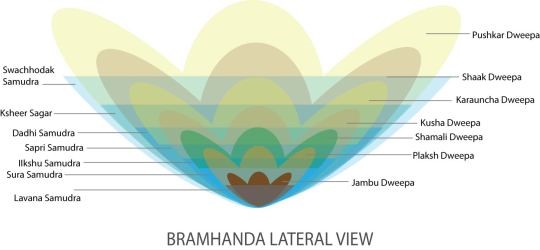
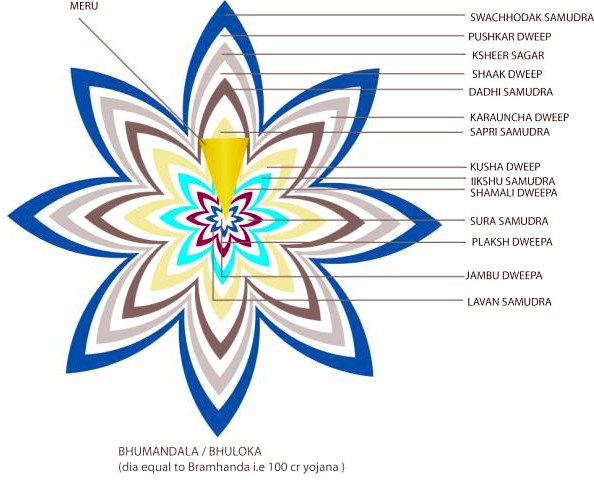
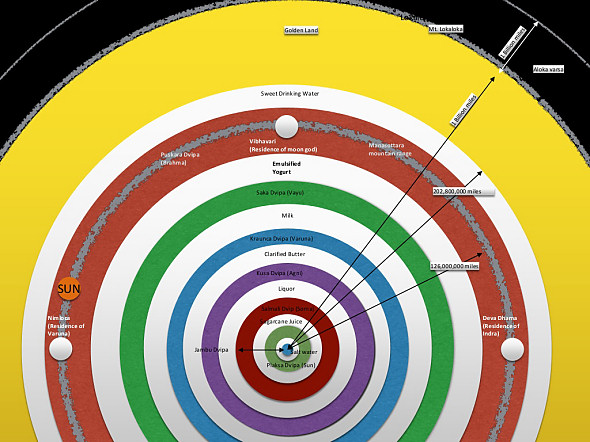
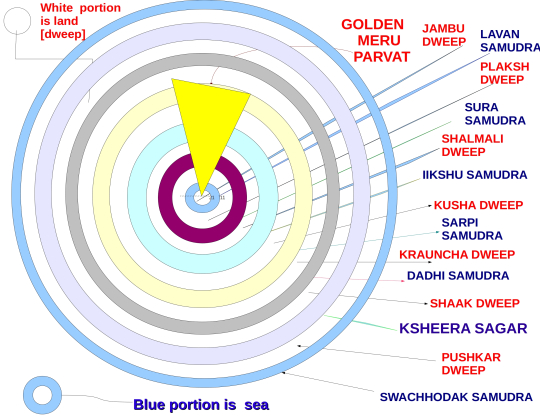
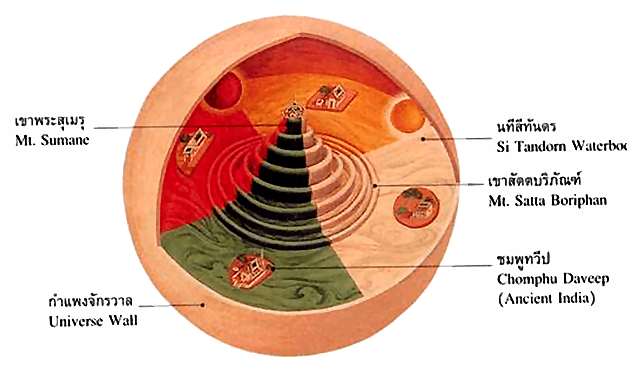
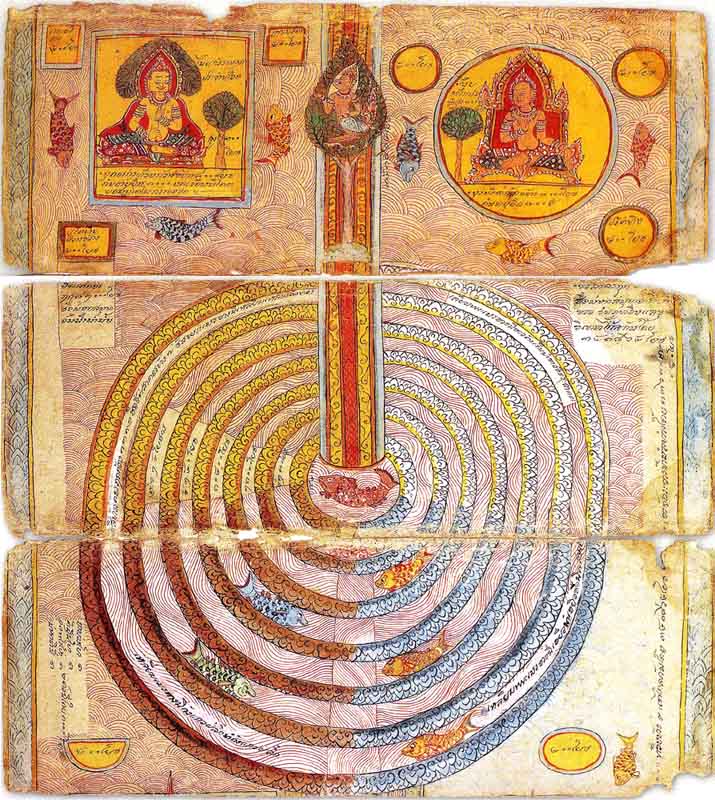
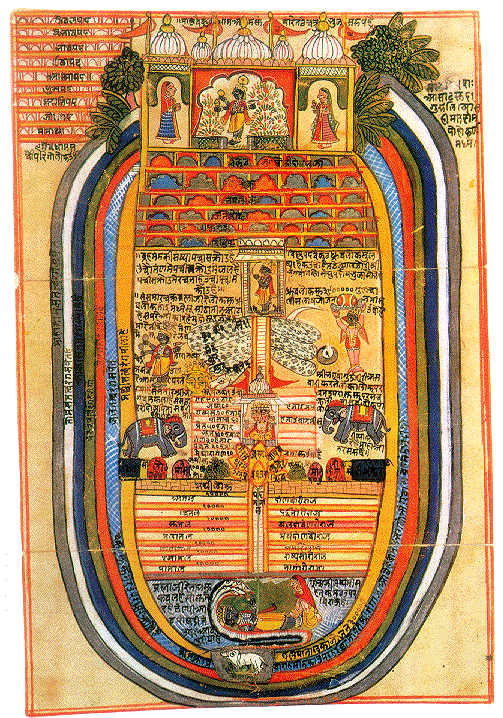
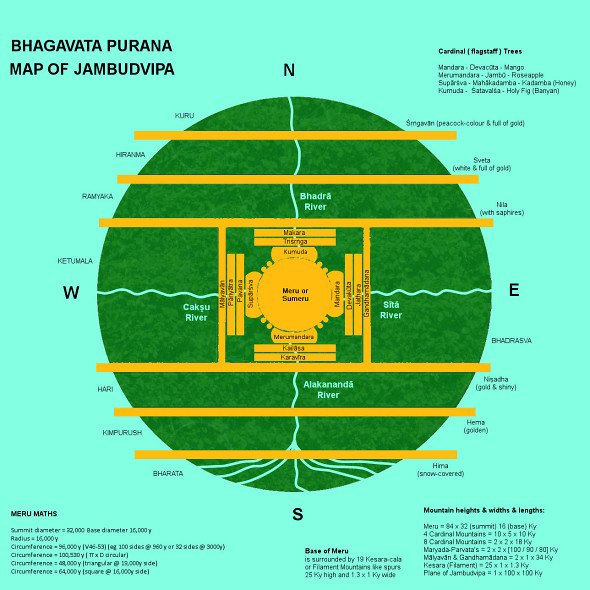
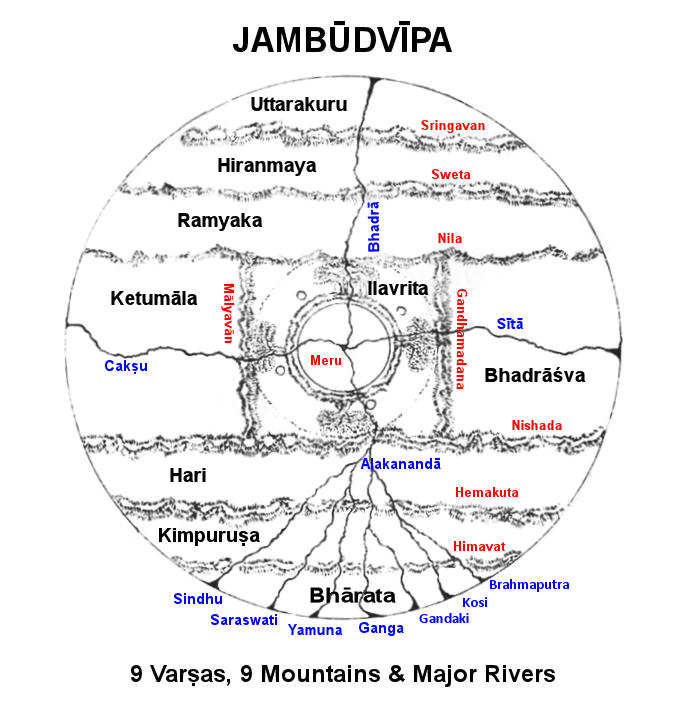
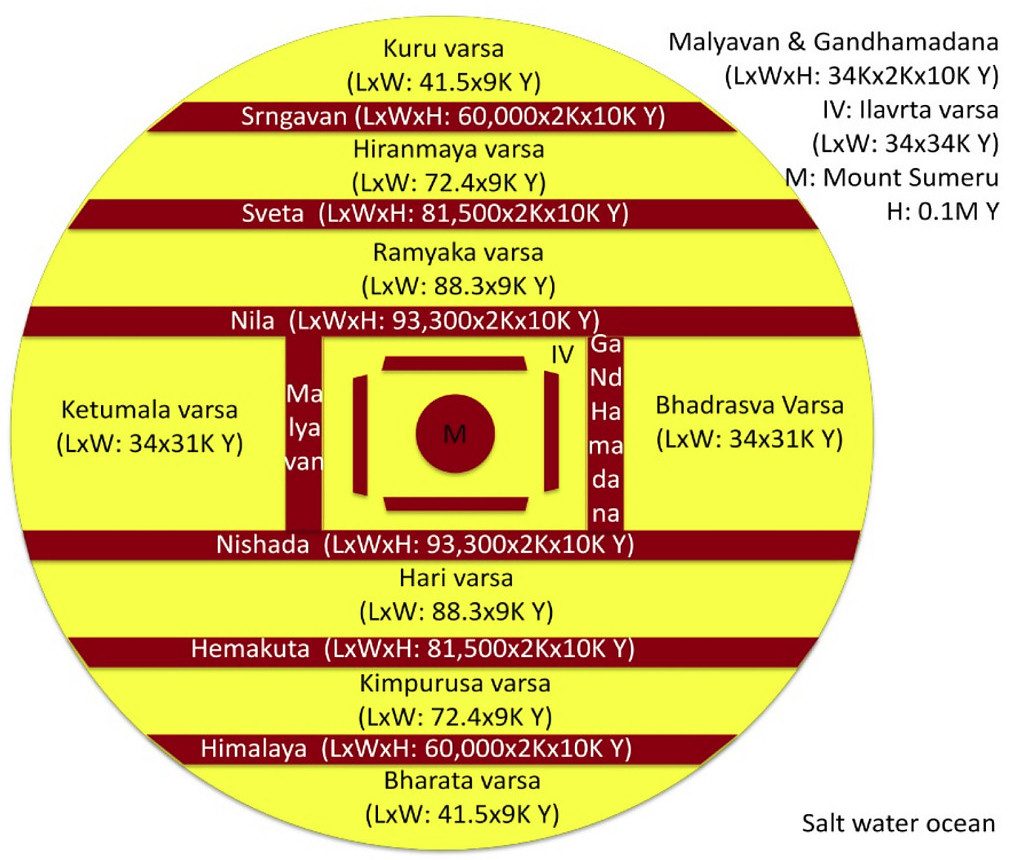
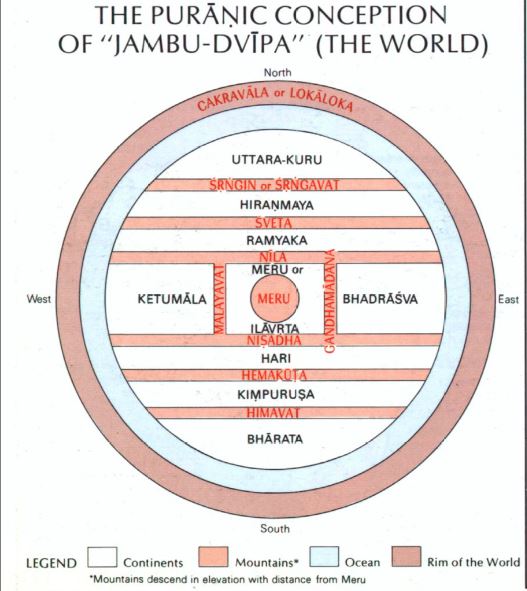
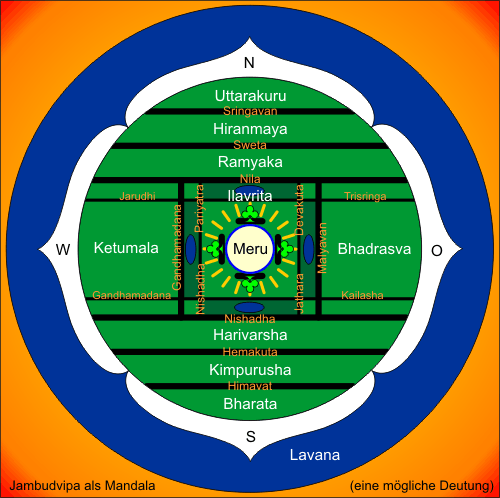
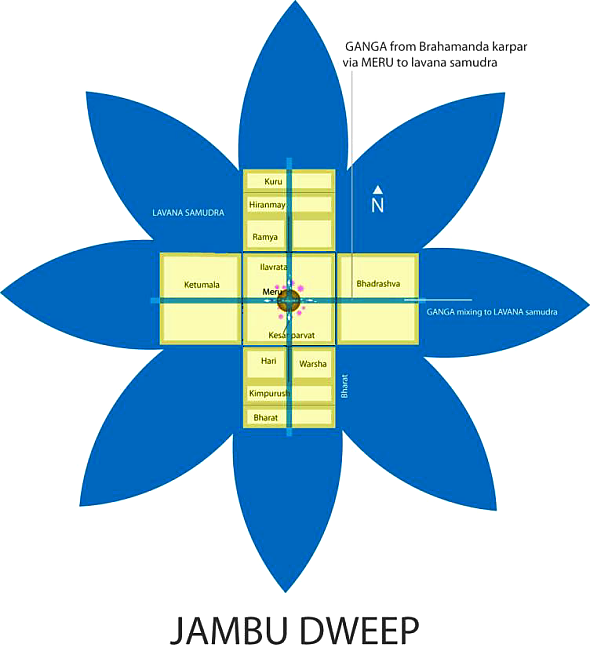
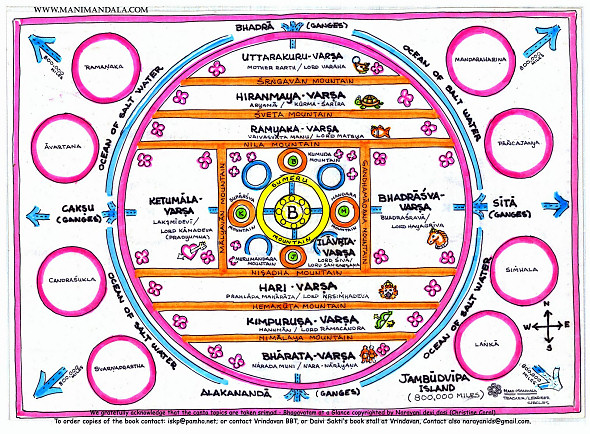
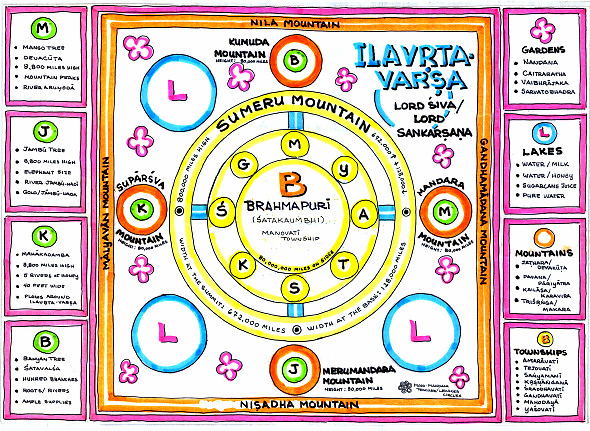
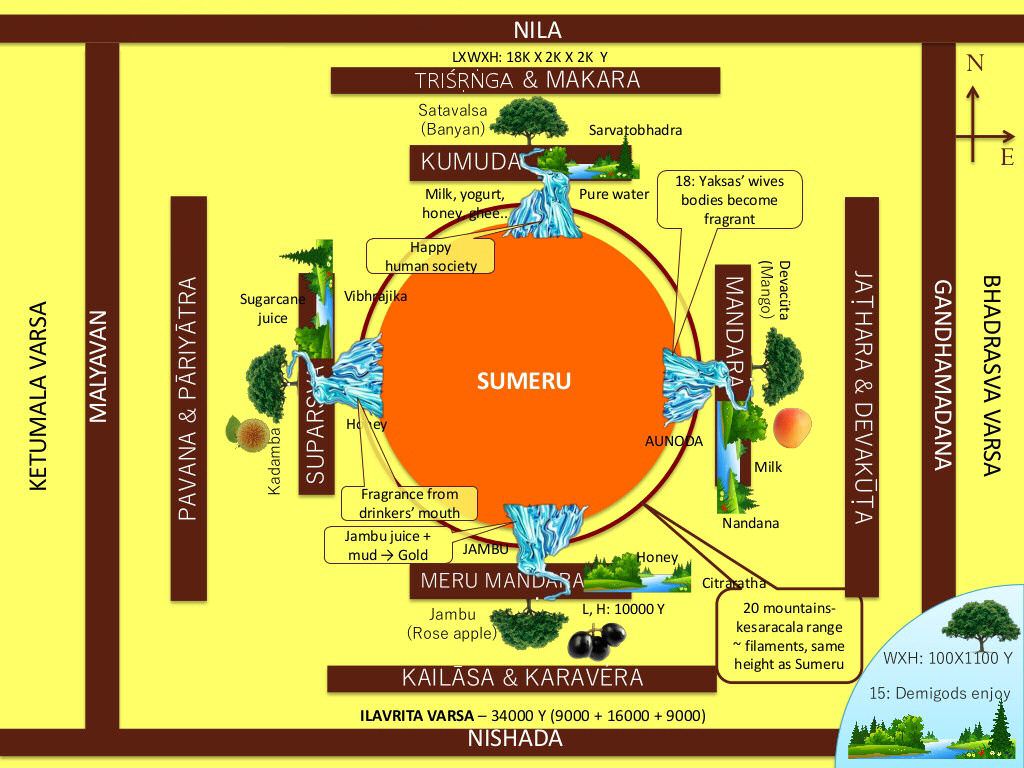

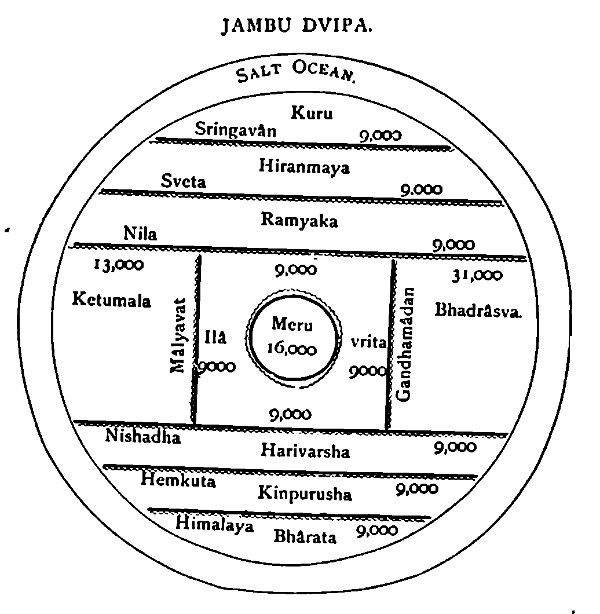
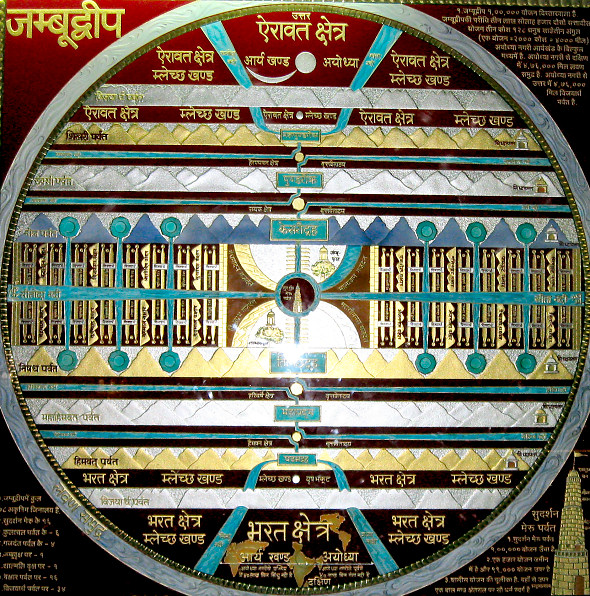
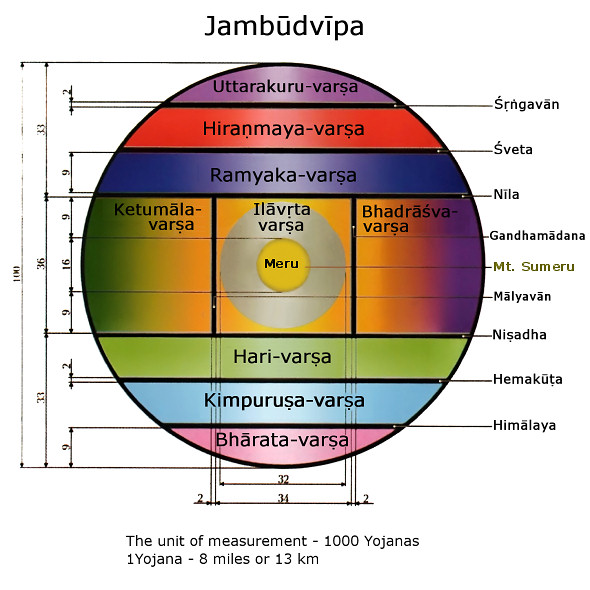
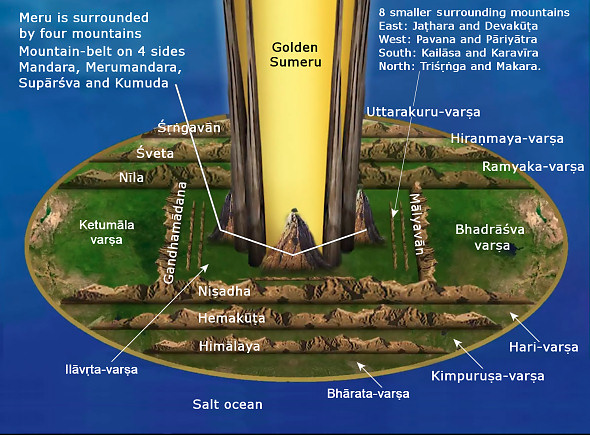
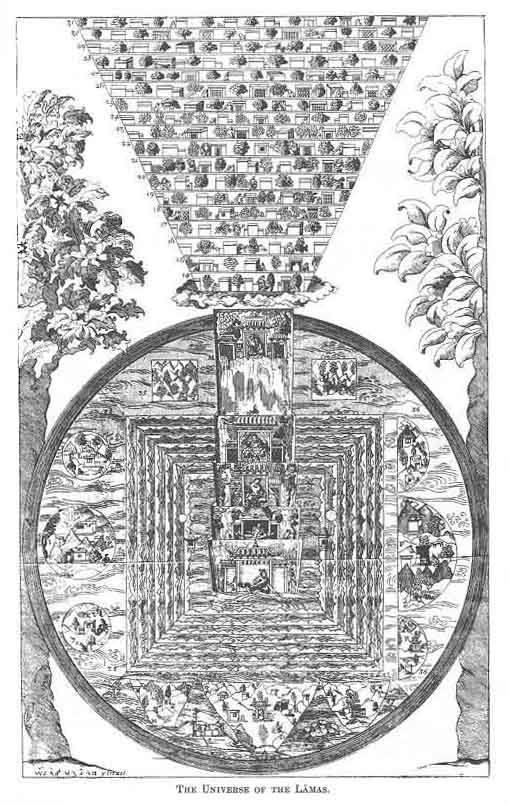
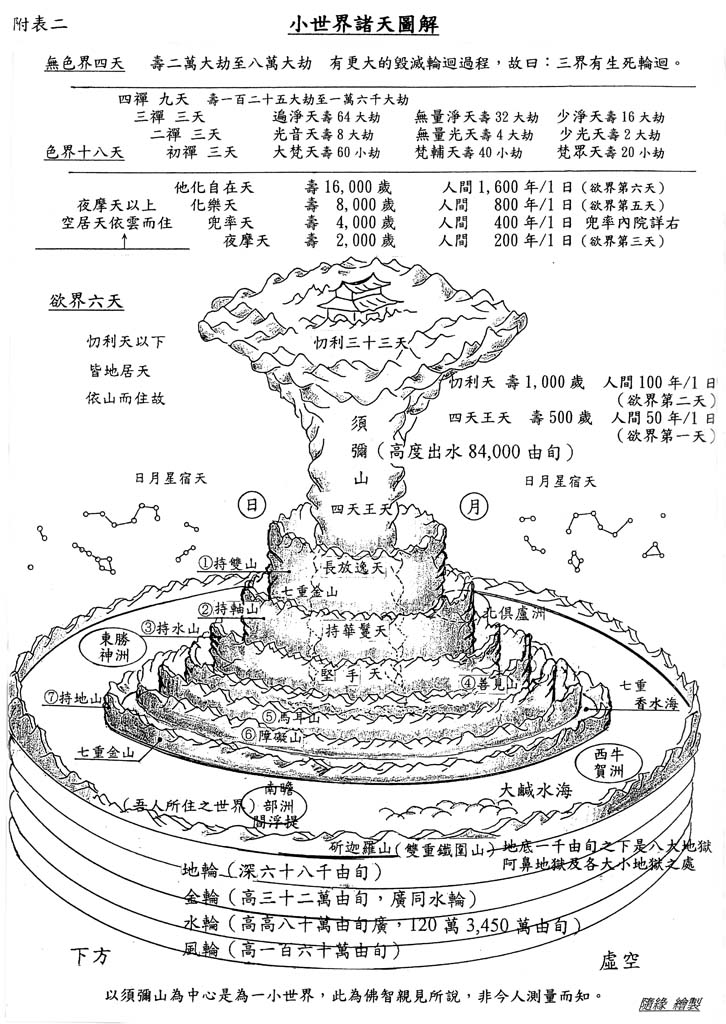
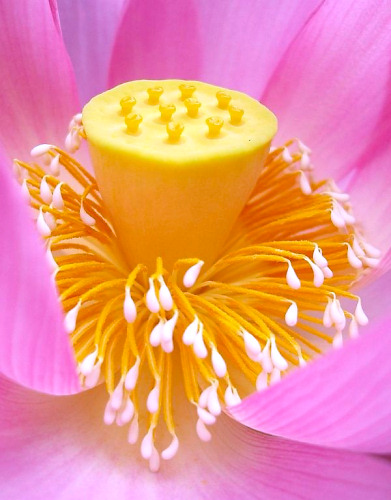
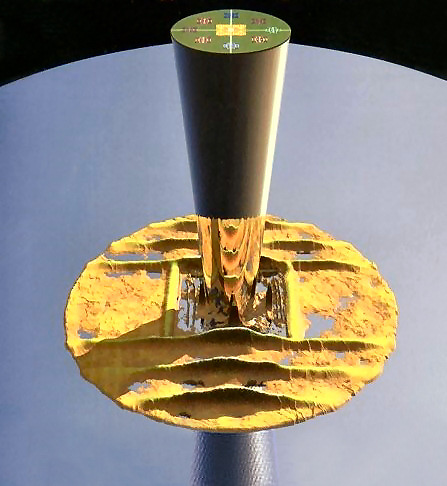

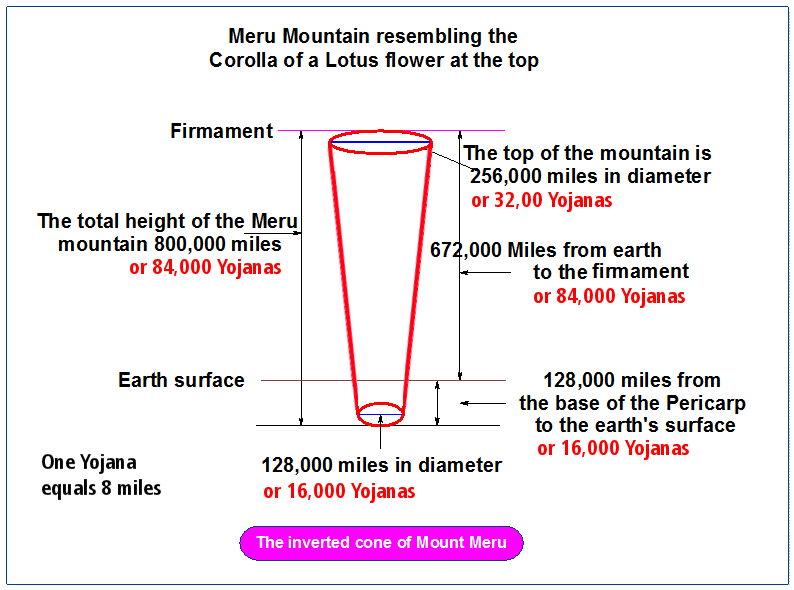
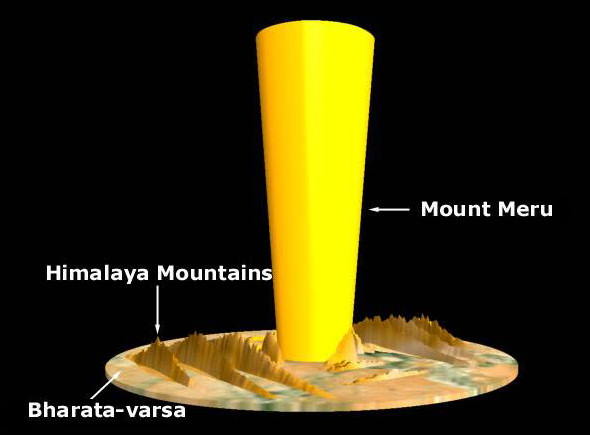
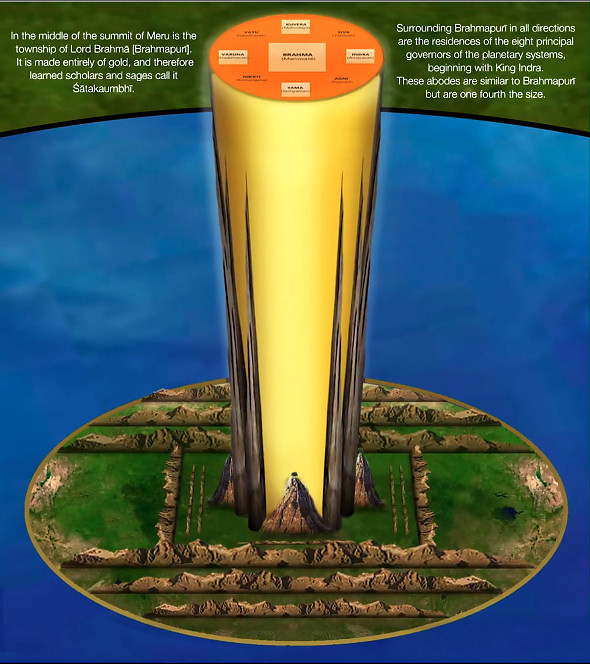
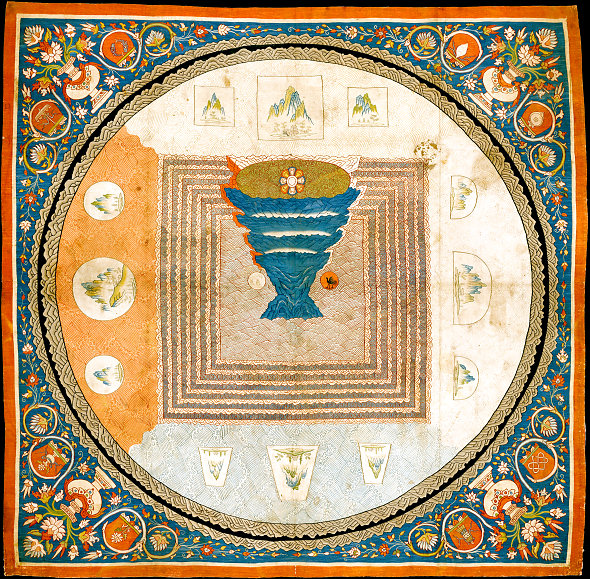
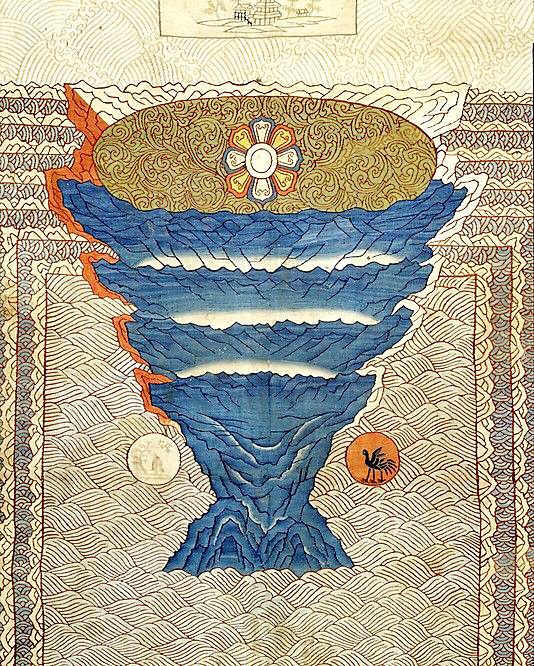
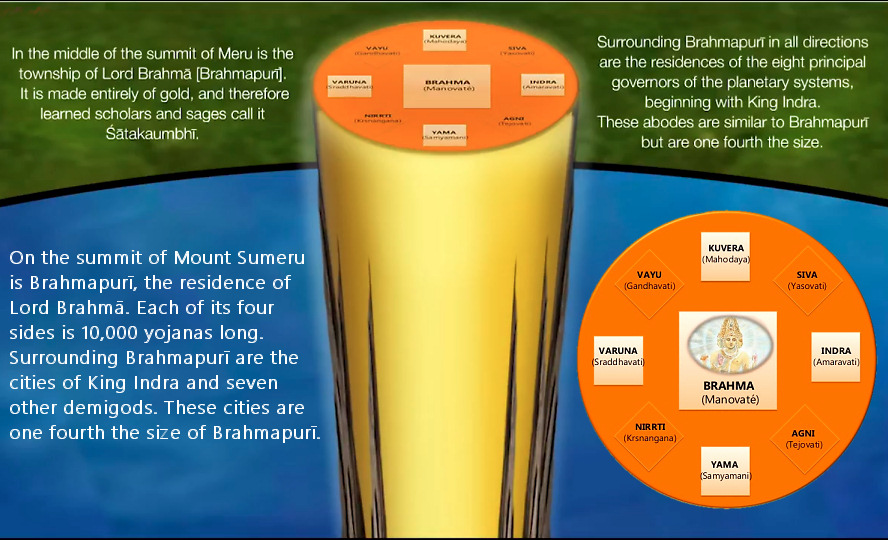
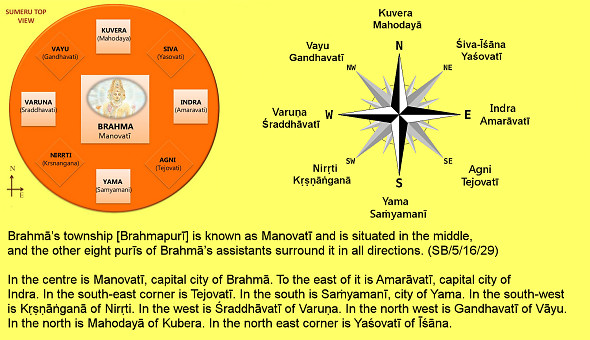

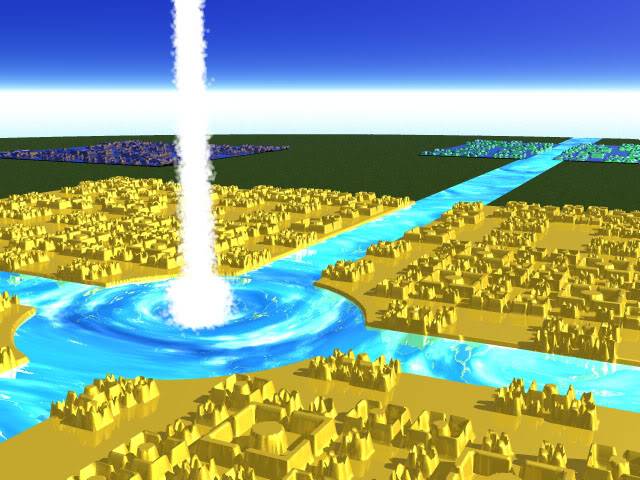
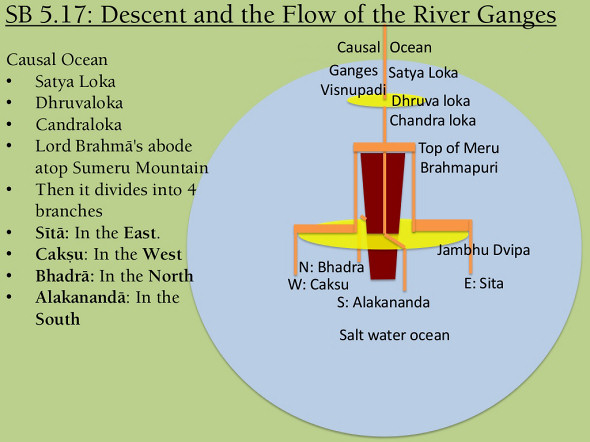
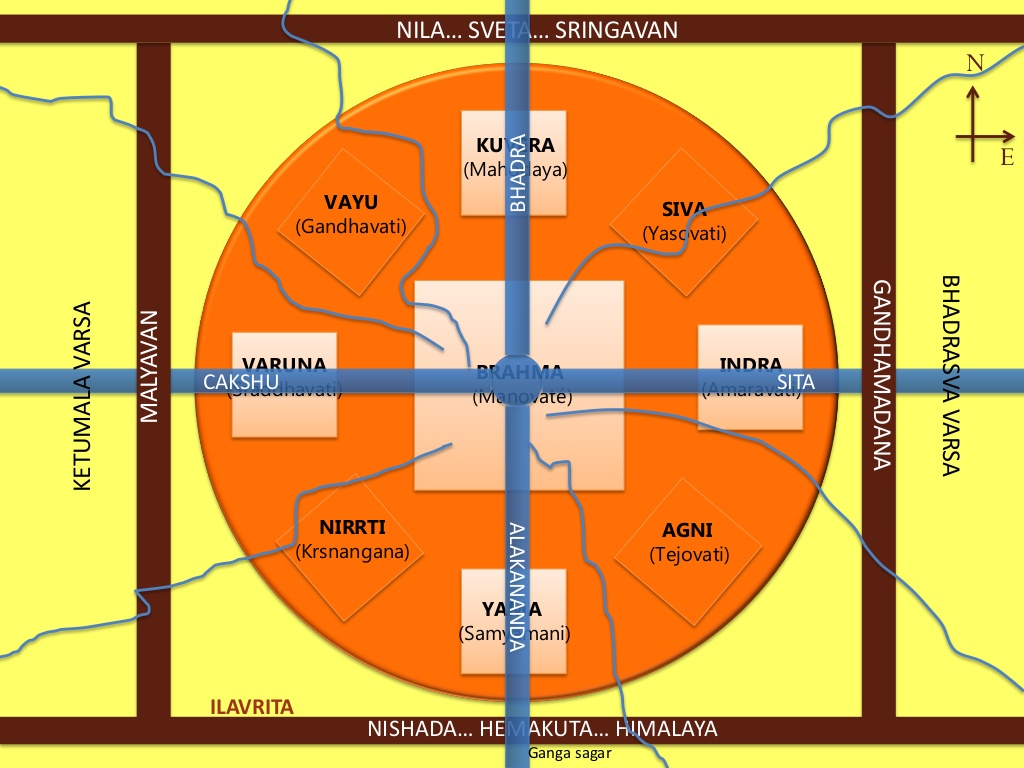
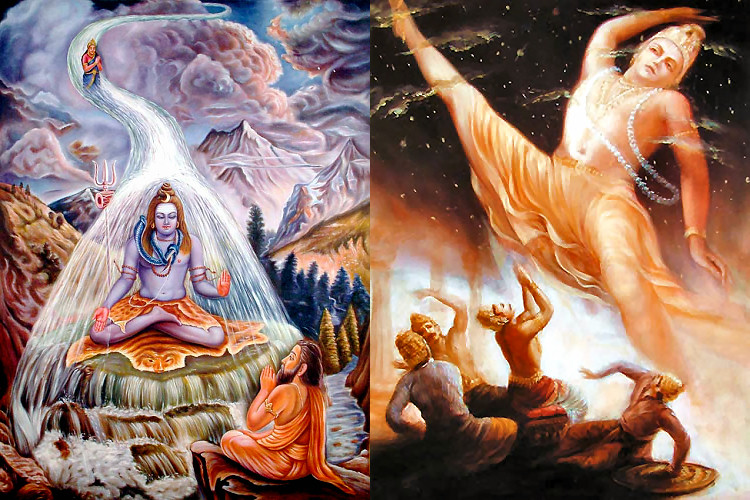








Thank you for the comprehensive articles about Vedic structure of Universe.
I read the description of Earthly planet (Jambudvipa), and come to understand what Srila Prabhupada refers as planet, actually he means an island (dvipa). In SB 1.16.12p (original Delhi edition), Srila Prabhupada also describes Bhadraswa as island, or as continent in the modern geographical context. When Prabhupada speaks about globe, he is referring to planet or island. There are different kind of islands, like smaller coastline islands, bigger islands or continents, huge islands or planets, etc. Prabhupada explains “Each planet is factually an island in the airy ocean of outer space. Jambudwipa is one of such countless islands in the airy ocean of the outer space.” I can not comprehend how Jambudwipa can be surrounded by the airy ocean of the outer space, and also at the same time is surrounded by salt ocean. Does this kind of air contains salt? Also, in the same purport, Srila Prabhupada describes that “According to Sridharswami these parts of the world is called Ilavrita Varsa or the Meditarian countries of Europe”. Can anyone with knowledge explain how these descriptions can be understood with regard to the above pictures and explanations? Thank you.
Hare Krishna. All glories to Srila Prabhupada.
730930BG.BOM Lectures
That point is missing. Real enjoyer or proprietor is Krsna. Bhoktaram yajna-tapasam sarva-loka-mahesvaram. He’s the proprietor. Sarva loka, not only of this loka, earthly planet, but there are innumerable planets within this universe and there are innumerable universes also, not one universe. Yasya prabha prabhavato jagad-anda-koti. Jagad-anda means universe. It is just like egg shape. anda. You can see this universe, the sky is…, horizon. So it is just like egg shape. ALL THE PLANETS AND THE UNIVERSES, THEY ARE EGG SHAPED. Therefore they are called anda, jagad-anda, brahmanda. So this jagad-anda
++++++++++++++++++++++++++++++++++++
TEXT 1
brahmovāca
yatrodyataḥ kṣiti-taloddharaṇāya bibhrat
krauḍīṁ tanuṁ sakala-yajña-mayīm anantaḥ
antar-mahārṇava upāgatam ādi-daityaṁ
taṁ daṁṣṭrayādrim iva vajra-dharo dadāra
SYNONYMS
brahmā uvāca—Lord Brahmā said; yatra—at that time (when); udyataḥ—attempted; kṣiti-tala—the planet earth; uddharaṇāya—for the matter of lifting; bibhrat—assumed; krauḍīm—pastimes; tanum—form; sakala—total; yajña-mayīm—all-inclusive sacrifices; anantaḥ—the Unlimited; antar—within the universe; mahā-arṇave—the great Garbha Ocean; upāgatam—having arrived at; ādi—the first; daityam—demon; tam—him; daṁṣṭrayā—by the tusk; adrim—the flying mountains; iva—like; vajra-dharaḥ—the controller of the thunderbolts; dadāra—pierced.
TRANSLATION
Lord Brahmā said: When the unlimitedly powerful Lord assumed the form of a boar as a pastime, just to lift the planet earth, which was drowned in the great ocean of the universe called the Garbhodaka, the first demon [Hiraṇyākṣa] appeared, and the Lord pierced him with His tusk.
PURPORT
Since the beginning of creation, the demons and the demigods, or the Vaiṣṇavas, are always the two classes of living beings to dominate the planets of the universes. Lord Brahmā is the first demigod, and Hiraṇyākṣa is the first demon in this universe. ONLY UNDER CERTAIN CONDITIONS DO THE PLANETS FLOAT AS WEIGHTLESS BALLS IN THE AIR, AND AS SOON AS THESE CONDITIONS ARE DISTURBED, THE PLANETS MAY FALL DOWN IN THE GARBHODAKA OCEAN, WHICH COVERS HALF THE UNIVERSE. THE OTHER HALF IS THE SPHERICAL DOME WITHIN WHICH THE INNUMERABLE PLANETARY SYSTEMS EXIST. THE FLOATING OF THE PLANETS IN THE WEIGHTLESS AIR IS DUE TO THE INNER CONSTITUTION OF THE GLOBES, AND THE MODERNIZED DRILLING OF THE EARTH TO EXPLOIT OIL FROM WITHIN IS A SORT OF DISTURBANCE BY THE MODERN DEMONS AND CAN RESULT IN A GREATLY HARMFUL REACTION TO THE FLOATING CONDITION OF THE EARTH. A similar disturbance was created formerly by the demons headed by Hiraṇyākṣa (the great exploiter of the gold rush), and the earth was detached from its weightless condition and fell down into the Garbhodaka Ocean. The Lord, as maintainer of the whole creation of the material world, therefore assumed the gigantic form of a boar with a proportionate snout and picked up the earth from within the water of Garbhodaka. Śrī Jayadeva Gosvāmī, the great Vaiṣṇava poet, sang as follows:
vasati daśana-śikhare dharaṇī tava lagnā
śaśini kalaṅka-kaleva nimagnā
keśava dhṛta-śūkara-rūpa
jaya jagadīśa hare
“O Keśava! O Supreme Lord who have assumed the form of a boar! O Lord! The planet earth rested on Your tusks, and it appeared like the moon engraved with spots.”
Such is the symptom of an incarnation of the Lord. The incarnation of the Lord is not the concocted idea of fanciful men who create an incarnation out of imagination. The incarnation of the Lord appears under certain extraordinary circumstances like the above-mentioned occasion, and the incarnation performs a task which is not even imaginable by the tiny brain of mankind. The modern creators of the many cheap incarnations may take note of the factual incarnation of God as the gigantic boar with a suitable snout to carry the planet earth.
When the Lord appeared to pick up the earth, the demon of the name Hiraṇyākṣa tried to create a disturbance in the methodical functions of the Lord, and therefore he was killed by being pierced by the Lord’s tusk. According to Śrīla Jīva Gosvāmī, the demon Hiraṇyākṣa was killed by the hand of the Lord. Therefore his version is that after being killed by the hand of the Lord, the demon was pierced by the tusk. Śrīla Viśvanātha Cakravartī Ṭhākura confirms this version.
Link to this page: https://prabhupadabooks.com/sb/2/7/1
++++++++++++++++++++++++++++++++++
Madhya 20.218 Lord Sri Caitanya Mahaprabhu Instructs Sanatana Gosvami in the Science
“Within the universe the Lord is situated in different spiritual manifestations. THESE ARE SITUATED ON SEVEN ISLANDS IN NINE SECTIONS. Thus Their pastimes are going on.
PURPORT
The seven islands are mentioned in the Siddhanta-siromani:
bhumer ardham ksira-sindhor udaka-stham
jambu-dvipam prahur acarya-varyah
ardhe ‘nyasmin dvipa-satkasya yamye
ksara-ksirady-ambudhinam nivesah
sakam tatah salmala-matra kausam
krauncam ca go-medaka-puskare ca
dvayor dvayor antaram ekam ekam
samudrayor dvipam udaharanti
The seven islands (dvipas) are known as (1) Jambu, (2) Saka, (3) Salmali, (4) Kusa, (5) Kraunca, (6) Gomeda, or Plaksa, and (7) Puskara. The planets are called dvipa. OUTER SPACE IS LIKE AN OCEAN OF AIR. JUST AS THERE ARE ISLANDS IN THE WATERY OCEAN, THESE PLANETS IN THE OCEAN OF SPACE ARE CALLED DVIPAS, OR ISLANDS IN OUTER SPACE. There are nine khandas, known as (1) Bharata, (2) Kinnara, (3) Hari, (4) Kuru, (5) Hiranmaya, (6) Ramyaka, (7) Ilavrta, (8) Bhadrasva and (9) Ketumala. These are different parts of the Jambudvipa. A valley between two mountains is called a khanda or varsa.
TEXT 21
māṁ vipāṭyājarāṁ nāvaṁ
yatra viśvaṁ pratiṣṭhitam
ātmānaṁ ca prajāś cemāḥ
katham ambhasi dhāsyasi
SYNONYMS
mām—me; vipāṭya—breaking to pieces; ajarām—very strong; nāvam—boat; yatra—where; viśvam—all worldly paraphernalia; pratiṣṭhitam—standing; ātmānam—yourself; ca—and; prajāḥ—your subjects; ca—also; imāḥ—all these; katham—how; ambhasi—in the water; dhāsyasi—you will hold.
TRANSLATION
The cow-shaped earth continued: My dear King, I am just like a strong boat, and all the paraphernalia of the world is standing upon me. If you break me to pieces, how can you protect yourself and your subjects from drowning?
PURPORT
Beneath the entire planetary system is the garbha water. Lord Viṣṇu lies on this garbha water, and from His abdomen a lotus stem grows, and all the planets within the universe are floating in the air, being supported by this lotus stem. If a planet is destroyed, it must fall into the water of garbha. The earth therefore warned King Pṛthu that he could gain nothing by destroying her. Indeed, how would he protect himself and his citizens from drowning in the garbha water? In other words, outer space may be COMPARED TO AN OCEAN OF AIR, and each and every planet is floating on it just as a boat or island floats on the ocean. SOMETIMES PLANETS ARE CALLED DVĪPA, OR ISLANDS, AND SOMETIMES THEY ARE CALLED BOATS. Thus the cosmic manifestation is partially explained in this reference by the cow-shaped earth.
Link to this page: https://prabhupadabooks.com/sb/4/17/21
+++++++++++++++++++++++++++++++
ALL THE PLANETS AND THE UNIVERSES, THEY ARE EGG SHAPED
http://www.prabhupadanugas.eu/news/?p=48520
++++++++++++++++++++++++++++++++++++++++++++++++
Note: Regards ocean of milk, ocean of salt etc:
Letter to: Muralidhara
—
Seattle
21 October, 1968
68-10-21
Regarding your question, what color is the ocean of milk, it is white. You can make it bluish shade in order to distinguish that it is water.
++++++++++++++++++++++++++++++++++++++++++++
Seated on His chariot with Arjuna, Kṛṣṇa began to proceed north, crossing over many planetary systems. These are described in the Śrīmad-Bhāgavatam as sapta-dvīpa. DVĪPA MEANS ISLAND. ALL THESE PLANETS ARE SOMETIMES DESCRIBED IN THE VEDIC LITERATURE AS DVIPAS. THE PLANET ON WHICH WE ARE LIVING IS CALLED JAMBŪDVĪPA. OUTER SPACE IS TAKEN AS A GREAT OCEAN OF AIR, AND WITHIN THAT GREAT OCEAN OF AIR THERE ARE MANY ISLANDS, WHICH ARE THE DIFFERENT PLANETS. IN EACH AND EVERY PLANET THERE ARE OCEANS ALSO. IN SOME OF THE PLANETS, THE OCEANS ARE OF SALT WATER, AND IN SOME OF THEM THERE ARE OCEANS OF MILK. IN OTHERS THERE ARE OCEANS OF LIQUOR, AND IN OTHERS THERE ARE OCEANS OF GHEE OR OIL. THERE ARE DIFFERENT KINDS OF MOUNTAINS ALSO. EACH AND EVERY PLANET HAS A DIFFERENT TYPE OF ATMOSPHERE.
Kṛṣṇa passed over all these planets and reached the covering of the universe. This covering is described in the Śrīmad-Bhāgavatam as great darkness. This material world as a whole is described as dark. In the open space there is sunlight, and therefore it is illuminated, but in the covering, because of the absence of sunlight, it is naturally dark. When Kṛṣṇa approached the covering layer of this universe, the four horses which were drawing His chariot–Śaibya, Sugrīva, Meghapuṣpa and Balāhaka–all appeared to hesitate to enter the darkness. This hesitation is also a part of the pastimes of Lord Kṛṣṇa because the horses of Kṛṣṇa are not ordinary. It is not possible for ordinary horses to go all over the universe and then enter into its outer covering layers. AS KṚṢṆA IS TRANSCENDENTAL, SIMILARLY HIS CHARIOT AND HIS HORSES AND EVERYTHING ABOUT HIM ARE ALSO TRANSCENDENTAL, BEYOND THE QUALITIES OF THIS MATERIAL WORLD. WE SHOULD ALWAYS REMEMBER THAT KṚṢṆA WAS PLAYING THE PART OF AN ORDINARY HUMAN BEING, AND HIS HORSES ALSO, BY THE WILL OF KṚṢṆA, PLAYED THE PARTS OF ORDINARY HORSES IN HESITATING TO ENTER THE DARKNESS.
Kṛṣṇa is known as Yogeśvara, as is stated in the last portion of Bhagavad-gītā. Yogeśvara hariḥ: all mystic powers are under His control. In our experience, we can see many human beings who have yogic mystic power. SOMETIMES THEY PERFORM VERY WONDERFUL ACTS, BUT KṚṢṆA IS UNDERSTOOD TO BE THE MASTER OF ALL MYSTIC POWER. Therefore, when He saw that His horses were hesitant to proceed into the darkness, He immediately released His disc, known as the Sudarśana cakra, which illuminated the sky a thousand times brighter than sunlight. The darkness of the covering of the universe is also a creation of Kṛṣṇa’s, and the Sudarśana cakra is Kṛṣṇa’s constant companion. Thus the darkness was penetrated by His keeping the Sudarśana cakra in front. The Śrīmad-Bhāgavatam states that the Sudarśana cakra penetrated the darkness just as an arrow released from the Śārṅga bow of Lord Rāmacandra penetrated the army of Rāvaṇa. Su means very nice, and darsana means observation; by the grace of Lord Kṛṣṇa’s disc, Sudarśana, everything can be seen very nicely, and nothing can remain in darkness. Thus Lord Kṛṣṇa and Arjuna crossed over the great region of darkness covering the material universes.
Arjuna then saw the effulgence of light known as the brahmajyoti. The brahmajyoti is situated outside the covering of the material universes, and because it cannot be seen with our present eyes, this brahmajyoti is sometimes called avyakta. This spiritual effulgence is the ultimate destination of the impersonalists known as Vedāntists. The brahmajyoti is also described as anantapāram, unlimited and unfathomed. When Lord Kṛṣṇa and Arjuna reached this region of the brahmajyoti, Arjuna could not tolerate the glaring effulgence, and he closed his eyes. Lord Kṛṣṇa’s and Arjuna’s reaching the brahmajyoti region is described in Harivaṁśa. In that portion of the Vedic literature, Kṛṣṇa informed Arjuna, “My dear Arjuna, the glaring effulgence, the transcendental light which you are seeing, is My bodily rays. O chief of the descendants of Bharata, this brahmajyoti is Myself.” As the sun disc and the sunshine cannot be separated, similarly Kṛṣṇa and His bodily rays, the brahmajyoti, cannot be separated. Thus Kṛṣṇa claimed that the brahmajyoti is He Himself. This is clearly stated in the Harivaṁśa, when Kṛṣṇa says, “ahaṁ saḥ.” The brahmajyoti is a combination of the minute particles known as spiritual sparks, or the living entities known as citkana. The Vedic word so’ham, or “I am the brahmajyoti,” can also be applied to the living entities, who can also claim to belong to the brahmajyoti. In the Harivaṁśa, Kṛṣṇa further explains, “This brahmajyoti is an expansion of My spiritual energy.”
Kṛṣṇa told Arjuna, “The brahmajyoti is beyond the region of My external energy, known as māyā-śakti.” When one is situated within this material world, it is not possible for him to experience this Brahman effulgence. Therefore, in the material world this effulgence is not manifested, whereas in the spiritual world, it is manifested. That is the purport of the words vyakta-avyakta. In the Bhagavad-gītā it is said avyakto ’vyaktāt sanātanaḥ: both these energies are eternally manifested.
After this, Lord Kṛṣṇa and Arjuna entered a vast extensive spiritual water. This spiritual water is called the Kāraṇārṇava Ocean or Virajā which means that this ocean is the origin of the creation of the material world. In the Mṛtyuñjaya Tantra, a Vedic literature, there is a vivid description of this Kāraṇa Ocean, or Virajā. It is stated there that the highest planetary system within the material world is Satyaloka, or Brahmaloka. Beyond that there are Rudraloka and Mahā-Viṣṇuloka. Regarding this Mahā-Viṣṇuloka, it is stated in the Brahma-saṁhitā, yaḥ kāraṇārṇava-jale bhajati sma yoga: “Lord Mahā-Viṣṇu is lying in the Kāraṇa Ocean. When He exhales, innumerable universes come into existence, and when He inhales, innumerable universes enter within Him.” In this way, the material creation is generated and again withdrawn. When Lord Kṛṣṇa and Arjuna entered the water, it appeared that there was a strong hurricane of transcendental effulgence brewing, and the water of the Kāraṇa Ocean was greatly agitated. By the grace of Lord Kṛṣṇa, Arjuna had the unique experience of being able to see the very beautiful Kāraṇa Ocean.
Accompanied by Kṛṣṇa, Arjuna saw a large palace within the water. There were many thousands of pillars and columns made of valuable jewels, and the glaring effulgence of those columns was so beautiful that Arjuna became charmed by it. Within that palace, Arjuna and Kṛṣṇa saw the gigantic form of Anantadeva, who is also known as Śeṣa. Lord Anantadeva or Śeṣanāga was in the form of a great serpent with thousands of hoods, and each one of them was decorated with valuable, effulgent jewels, which were beautifully dazzling. Each of Anantadeva’s hoods had two eyes which appeared very fearful. His body was as white as the mountaintop of Kailāsa, which is always covered by snow. His neck was bluish, as were His tongues. Thus Arjuna saw the Śeṣanāga form, and he also saw that on the very soft, white body of Śeṣanāga, Lord Mahā-Viṣṇu was lying very comfortably. He appeared to be all-pervading and very powerful, and Arjuna could understand that the Supreme Personality of Godhead in that form is known as Puruṣottama. He is known as Puruṣottama, the best, or the Supreme Personality of Godhead, because from this form emanates another form of Viṣṇu, which is known as Garbhodakaśāyī Viṣṇu within the material world. The Mahā-Viṣṇu form of the Lord, Puruṣottama, is beyond the material world. He is also known as Uttama. Tama means darkness, and ut means above, transcendental; therefore, Uttama means above the darkest region of the material world. Arjuna saw that the bodily color of Puruṣottama, Mahā-Viṣṇu, was as dark as a new cloud in the rainy season; He was dressed in very nice yellow clothing, His face was always beautifully smiling, and His eyes, which were like lotus petals, were very attractive. Lord Mahā-Viṣṇu’s helmet was bedecked with valuable jewels, and His beautiful earrings enhanced the beauty of the curling hair on His head. Lord Mahā-Viṣṇu had eight arms, all very long, reaching to His knees. His neck was decorated with the Kaustubha jewel, and His chest was marked with the symbol of śrīvatsa, which means the resting place of the goddess of fortune. The Lord wore a garland of lotus flowers down to His knees. This long garland is known as a vaijayantī garland.
The Lord was surrounded by His personal associates Nanda and Sunanda, and the personified Sudarśana disc was also standing by Him. As is stated in the Vedas, the Lord has innumerable energies, and they were also standing there personified. The most important among them were as follows: puṣṭi, the energy for nourishment, śrī, the energy of beauty, kīrti, the energy of reputation, and ajā, the energy of material creation. All these energies are invested in the administrators of the material world, namely Lord Brahmā, Lord Śiva and Lord Viṣṇu, and in the kings of the heavenly planets, Indra, Candra, Varuṇa and the sun-god. In other words, all these demigods, being empowered by the Lord with certain energies, engage in the transcendental loving service of the Supreme Personality of Godhead. The Mahā-Viṣṇu feature is an expansion of Kṛṣṇa’s body. It is also confirmed in the Brahma-saṁhitā that Mahā-Viṣṇu is a portion of a plenary expansion of Kṛṣṇa. All such expansions are nondifferent from the Personality of Godhead, but since Kṛṣṇa appeared within this material world to manifest His pastimes as a human being, He and Arjuna immediately offered their respects to Lord Mahā-Viṣṇu by bowing down before Him. It is stated in the Śrīmad-Bhāgavatam that Lord Kṛṣṇa offered respect to Mahā-Viṣṇu; this means that He offered obeisances unto Him only because Lord Mahā-Viṣṇu is nondifferent from He Himself. This offering of obeisances by Kṛṣṇa to Mahā-Viṣṇu is not, however, the form of worship known as ahaṅgraha-upāsanā, which is sometimes recommended for persons who are trying to elevate themselves to the spiritual world by performing the sacrifice of knowledge. This is also stated in the Bhagavad-gītā: jñāna-yajñena cāpy ante yajanto mām upāsate.
Although there was no necessity for Kṛṣṇa to offer obeisances, because He is the master teacher, He taught Arjuna just how respect should be offered to Lord Mahā-Viṣṇu. Arjuna, however, became very much afraid upon seeing the gigantic form of everything, distinct from the material experience. Seeing Kṛṣṇa offering obeisances to Lord Mahā-Viṣṇu, he immediately followed Him and stood before the Lord with folded hands. After this, the gigantic form of Mahā-Viṣṇu, greatly pleased, smiled pleasingly and spoke as follows.
“My dear Kṛṣṇa and Arjuna, I was very anxious to see you both, and therefore I arranged to take away the babies of the brāhmaṇa and keep them here. I have been expecting to see you both at this palace. You have appeared in the material world as My incarnations in order to minimize the force of the demoniac persons who burden the world. Now after killing all these unwanted demons, you will please again come back to Me. Both of you are incarnations of the great sage Nara-Nārāyaṇa. Although you are both complete in yourselves, to protect the devotees and to annihilate the demons and especially to establish religious principles in the world so that peace and tranquility may continue, you are teaching the basic principles of factual religion so that the people of the world may follow you and thereby be peaceful and prosperous.”
Both Lord Kṛṣṇa and Arjuna then offered their obeisances to Lord Mahā-Viṣṇu, and taking back the brāhmaṇa’s children, they returned to Dvārakā via the same route by which they had entered the spiritual world. All the children of the brāhmaṇa had duly grown up. After returning to Dvārakā, Lord Kṛṣṇa and Arjuna delivered to the brāhmaṇa all of his sons.
Arjuna, however, was struck with great wonder after visiting the transcendental world by the grace of Lord Kṛṣṇa. And by the grace of Kṛṣṇa he could understand that whatever opulence there may be within this material world is an emanation from Him. Any opulent position a person may have within this material world is due to Kṛṣṇa’s mercy. One should therefore always be in Kṛṣṇa consciousness, in complete gratefulness to Lord Kṛṣṇa, because whatever one may possess is all His mercy.
Arjuna’s wonderful experience due to the mercy of Kṛṣṇa is one of the many thousands of pastimes performed by Lord Kṛṣṇa during His stay in this material world. They were all unique and have no parallel in the history of the world. All these pastimes prove fully that Kṛṣṇa is the Supreme Personality of Godhead, yet while He was present within this material world, He played just like an ordinary man possessing many worldly duties. He played the part of an ideal householder, and although He possessed 16,000 wives, 16,000 palaces and 160,000 children, He also performed many sacrifices, just to teach the royal order how to live in the material world for the welfare of humanity. As the ideal Supreme Personality, He fulfilled the desires of everyone, from the brāhmaṇas, the highest persons in human society, down to the ordinary living entities, including the lowest of men. Just as King Indra is in charge of distributing rain all over the world to satisfy everyone in due course, so Lord Kṛṣṇa satisfies everyone by pouring down His causeless mercy. His mission was to give protection to the devotees and to kill the demoniac kings; therefore, He killed many hundreds and thousands of demons. Some of them He killed personally, and some of them were killed by Arjuna, who was deputed by Kṛṣṇa. In this way He established many pious kings such as Yudhiṣṭhira at the helm of world affairs. Thus, by His divine arrangement He created the good government of King Yudhiṣṭhira, and there ensued peace and tranquility.
Thus ends the Bhaktivedanta purport of the Second Volume, Thirty-fourth Chapter, of Kṛṣṇa, “The Superexcellent Power of Kṛṣṇa.”
Link to this page: https://prabhupadabooks.com/kb/2/34
Hare Krsna, Walter Prabhu,
I do not know these things but I read only Srila Prabhupada’s books and he says:
…He is still all-pervading and is maintaining everything. By Him all these planetary systems are sustained. We often wonder how these big planets are floating in the air. It is stated here that the Supreme Lord, by His inconceivable energy, is sustaining all these big planets and systems of galaxies. The word acintya (inconceivable) is very significant in this connection. God’s energy is beyond our conception, beyond our thinking jurisdiction, and is therefore called inconceivable (acintya). Who can argue this point? He pervades this material world and yet is beyond it. We cannot even comprehend this material world, which is insignificant compared to the spiritual world—so how can we comprehend what is beyond? Acintya means that which is beyond this material world, that which our argument, logic and philosophical speculation cannot touch, that which is inconceivable. Therefore intelligent persons, avoiding useless argument and speculation, should accept what is stated in scriptures like the Vedas, Gītā, and Śrīmad-Bhāgavatam and follow the principles they set down. This will lead one to understanding.
Bg.8.9
Hare Krsna
Thank you Marici prabhu for your kind explanation of things which are beyond our conception. But I am still of the sense that certain things we can and should understand to a certain degree, even Srila Prabhupada is favoring to give satisfactory explanations on transcendental subject. So we should not just blindly accept Vedic statements, and show ourselves and others a path of accepting absurd things which might be creation of our speculative thinking. Vedas, Gita and Srimad-Bhagavatam are mostly in form of questions and answers. I believe my questions are not useless arguments or speculation, but to understand better, and clarify my doubts, on points which I give before. I will very much appreciate a direct answer to my questions. If not, I thank you for care. Hare Krishna
Dear Marici Prabhu, thank you for posting these words by Srila Prabhupada.
This reminds me of the story of Lord Krishna ‘threading a camel through the eye of a needle!’ This is also of course Achintya (inconceiveable) and so the ”materially educated” man he is thinking with great scepticism, “How is this possible? I am finding this a hard pill to swallow!”, but the “simple” man he immediately understands the inconceiveable nature of Lords many potencies and thinks, “Oh! how wonderful is Lord Krishna!”
So with this topic it is proof that a little “material education” is a definite negative (in terms of increasing our devotion to lord Krishna) when it comes down to “inconceiveability” (Achintya), when ‘different parallel realities’ are simultaniously at play. What is ‘beyond our comprehension’ IS SIMPLY THAT!
IT IS NOT BEYOND OUR COMPREHENSION HOWEVER TO UNDERSTAND THE MOTIVES AND MODUS-OPERANDI OF THE DEMONIC, HIGHLY ORGANIZED, FREEMASON ILLUMINATI WHO’S CONSTRUCT IS MANIFEST (THOUGH HIGHLY COVERTLY) THROUGH SUCH ‘AGENCIES’ AS ELITIST “INTERNATIONAL” SECRET SOCIETIES (UR LODGES), THE GOVERNMENT, SECRET SERVICES, THE MILITARY INDUSTRIAL COMPLEX, THE CORPORATE SECTOR, THE BANKING SECTOR, THE MEDIA, “EDUCATION SYSTEM”, AND PARTICULARLY (IN THIS CASE) NASA AND THE SMITHSONIAN INSTITUTE. ALL OF THESE ENTITIES ARE “CREATED, CONTROLLED, MAINTAINED AND OPERATED BY THE FREEMASON ILLUMINATI” (WHICH IS AS IT’S CORE SATANIC AND EVIL). THIS HAS BEEN GOING ON FOR CENTURIES (IF NOT MILLENNIA) AND THEY MAINTAIN COMPLETE CONTROL OVER ALL OF WHAT THE DUMB POPULACE ARE LED TO BELIEVE. THE CORE GOAL OF THE FREEMASON ILLUMINATI CONTROLLED, NASA AND THE “SMITHSONIAN” IS TO DESTROY WHAT VESTIGES OF ‘FAITH IN GOD’ THAT STILL EXIST IN A POPULATION OF FOOLS CONTAMINATED BY HOMO-SEX, SLOTH, DEPRAVITY, MADNESS, DEPRESSION, DRUGS, IGNORANCE, VANITY AND GREED AND TO REINFORCE THEIR BELIEF THAT SATAN IS THE TRUE MASTER. IT IS AS SIMPLE AS THAT!
Hare Krsna, Walter Prabhu,
Yes , you are right.
And everyone has to use the own capability or talent in Krsna Consciousness. Surely there are devotees who have got proper knowledge to service Srila Prabhupada in this issue and you will get answer. But I think this issue will bring next questions and wants next answers.
My life is short and I try to do only the basic things. So I can not give a direct answer.
Hare Krsna
Hare Krishna Prabhus,
The Sarga and Visarga are complex creations. We have minute intelligence in comparison to Brahma and what to speak of the Supreme Lord. It is just like your 6-year-old comes and asks what is Calculus. Please explain.
What are you going to explain? Probably, how things are integrated by addition and multiplication and differentiated through division. It is a hard concept for the 6-year-old to grasp with their tiny intelligence. Similarly, we have tiny intelligence and the complex nitty-gritty of creation is hard for us to grasp.
There are various dimensions in the world. For example, if you observe the ants, you may soon find they live in a two-dimensional world. They barely understand the depth or height. The climb the wall without knowing they are walking vertically. We notice this due to our perception of the third dimension. Similarly, there were more dimensions in the previous ages. Srila Prabhupada touches upon in the context of Srila Vyasadeva.
Firstly, 1.3.21, states Srila Vyasadeva as 17th incarnation. Lord Rama appeared as 18th incarnation. How is this possible? Satyavati and Santanu were during Mahabharata period which was in Dvapara Yuga. However, Lord Rama appears in Treta Yuga and is still the 18th incarnation. The explanation lies in SB 1.4.14. Here Srila Prabhupada explains about the overlapping time. I understand my inability to comprehend this. However, with the words of our Spiritual Master, it is possible to get some glimpse of it after a little philosophical speculation.
In SB 1.4.14 it mentions a period of parallel time in the same space. In other words, this means that Dvapara Yuga and Treta Yuga were running in parallel. Also, it is to be noted here that Dva means two and Triya means three. According to the purport, usually, Dvapara is second Yuga and Treta is the third yuga. But during the time of Vaivasvata Manu during 28th cycle, the yugas flipped over and also did an overlap. So there were two Time dimensions in the same space for a period of time. In other words, it is very much possible that Ramayana and Mahabharata could have been happening in parallel in the same space in different parallel times. I am not trying to elude to something. This is not our job as devotees. Please excuse my speculation here. However, it is to prove a point. The point is that there are many things that can occur around us that will remain inconceivable. Especially, when we are tightly bound by time and space, due to our conditioning.
So, whether a planet is a ball or flat is not the point. Srimad Bhagavatam explains things from various points of view. Just like an architect, draws the blueprint of a house on paper. The house is three dimensional, yet it can be conceived on a paper. Similarly, the planet is in an egg shape, yet to explain the planar view of one of its section will require to view it as a flat surface.
We have to understand our incapacity and limit in comparison to the inconceivable potency of the Lord, who lives far away yet so near. He defies everything, including contradictions. I love the way Srila Prabhupada has given us Krishna Consciousness. It explains everything.
Yes, many excellent points made by Nitai Chand Prabhu. This is the conclusion. This ‘one mustard seed’ is SO INCONCEIVEABLE!, so what to speak of the WHOLE SACK OF MUSTARD SEEDS?, and this whole sack is only one quarter of creation! Everybody has seen mustard seed sacks, many millions of seeds. It is not possible to understand this! There are ‘billions’ of universes. We can only be in awe at the potency of Lord Krishna and pray for His mercy.
Nitai Chand Dasa : Just like an architect, draws the blueprint of a house on paper. The house is three dimensional, yet it can be conceived on a paper. Similarly, the planet is in an egg shape, yet to explain the planar view of one of its section will require to view it as a flat surface.
Mahesh: Srila Prabhupada explains it perfectly:
KB 82 Lord Krsna and Balarama Meet the Inhabitants of Vrndavana
The WHOLE philosophy is considered on the basis of INCONCEIVABLE, SIMULTANEOUS ONENESS AND DIFFERENCE.
Walter Prabhu writes ; ” …. Prabhupada explains “Each planet is factually an island in the airy ocean of outer space. Jambudwipa is one of such countless islands in the airy ocean of the outer space.” I can not comprehend how Jambudwipa can be surrounded by the airy ocean of the outer space, and also at the same time is surrounded by salt ocean. Does this kind of air contains salt? Also, in the same purport, Srila Prabhupada describes that “According to Sridharswami these parts of the world is called Ilavrita Varsa or the Meditarian countries of Europe”. Can anyone with knowledge explain how these descriptions can be understood with regard to the above pictures and explanations? ”
Airy Ocean of the Outer Space refers to the Astral Sky. For example, we see clouds in the sky which pour rains. So Clouds in the form of Rain are understood as an Ocean full of water in the Sphere of the Astral Sky.
The particular Realm of Jambudwipa which is one of the seven islands (dvipas) namely (1) Jambu, (2) Saka, (3) Salmali, (4) Kusa, (5) Kraunca, (6) Gomeda, or Plaksa, and (7) Puskara in the Astral Sky is further divided in to Nine Khandas or Lokas namely (1) Bharata, (2) Kinnara, (3) Hari, (4) Kuru, (5) Hiranmaya, (6) Ramyaka, (7) Ilavrta, (8) Bhadrasva and (9) Ketumala. These are different parts of the Jambudvipa. A valley between two mountains is called a khanda or varsa. The planets are called dvipa. OUTER SPACE IS LIKE AN OCEAN OF AIR. JUST AS THERE ARE ISLANDS IN THE WATERY OCEAN, THESE PLANETS IN THE OCEAN OF SPACE ARE CALLED DVIPAS, OR ISLANDS IN OUTER SPACE.
To understand the above mentioned structure better, our Jagat Guru His Divine Grace Srila Prabhupada describes in His letter to Svarupa Damodara dasa dated April 27, 1976 which you may read it here at this link in my comments dated 14. August 2018 at 8:31 pm on this web site ;
http://www.prabhupadanugas.eu/news/?p=49149#comment-52356.
I hope it gives some answers to your questions.
OM TAT SAT.
Hare Krishna. All Glories to Srila Prabhupada.